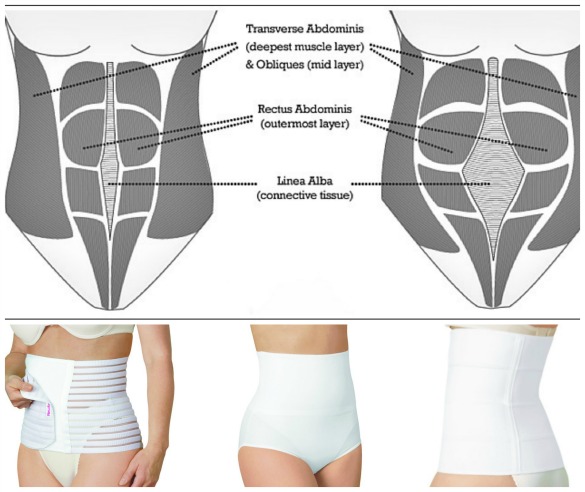Postpartum Belly Wraps: Will They Help Your Recovery?
The first six weeks after giving birth are full of obstacles. While there’s no easy fix for juggling sleepless nights and newborn-feeding issues, there are plenty of things that new moms can do to physically feel better during the postpartum period. Today, Stephanie Miles of PurpleLaurel.com, a boutique that sells postpartum essentials for new moms, shares everything you need to know about belly wrapping for childbirth recovery. I never used a belly wrap, but I love the company’s focus on the health of the new mom, rather than having a flat tummy as you walk out of the hospital! Read on for more if you’ve ever been curious about postpartum belly wraps!

“Nine months on, nine months off.”
Most new moms will hear that saying at least a dozen times during the first few weeks after giving birth, and for the most part the adage is true. While every woman’s pregnancy weight-loss timeline is unique, physicians almost universally recommend that new mothers focus on healthy eating and moderate exercise, rather than extreme diets or working out to the point of exhaustion. What many first-time moms still don’t realize is that there are safe ways to feel better and look better after birth, without having to sacrifice the breastfeeding relationship or relying on any unhealthy physical regimens.
Postpartum belly wrapping has been around for centuries, with ancient practice like Sarashi and Bengkung being used by women in Japanese and Malaysian cultures to tone the abdominal muscles after childbirth and speed up weight loss. Today’s wraps are made with advanced materials, like latex-free, medical-grade elastic, which makes them comfortable, adjustable, and ultimately more effective for slimming the waist and hips after childbirth. Modern postpartum belly wraps are frequently recommended by physicians, as well for recovery after C-section surgery.
Postpartum Belly Wrapping 101
The types of results that a new mom can expect to see after wearing a postpartum belly wrap depend on her own genetics, the type of wrap she chooses and how soon she begins wearing the wrap after giving birth. Because no two bodies are exactly alike, there’s no way to predict exactly how many sizes or inches a person will lose after wearing a postpartum belly wrap. (Anyone who claims to know is just plain wrong.)
The compression method of belly wrapping works best when women start wearing their wraps immediately after birth, or as soon as their physicians give the okay. Regardless of the brand or style that a new mom chooses, the wrap itself should be worn daily for six to 10 weeks after birth. Although there are places around the world where women bind their bellies for up to a year after childbirth, physicians in the U.S. recognize that the benefits of belly wrapping tend to wane after three to four months postpartum. By that time, a woman’s uterus should have shrunken back down to its pre-pregnancy size and her abdominal muscles should be knitted back together.
Belly Wrapping for Childbirth Recovery
Most of the articles written about postpartum belly wraps focus on the esthetic benefits, and those are significant. But at Purple Laurel, we believe it’s just as important to focus on the physical benefits of postpartum belly wrapping. Namely, that postpartum wrapping can aid in back support, help with muscle memory, provide support during breastfeeding, and decrease pressure on the back and legs. True abdominal compression wraps also speed up the recovery process after C-section surgery.

For women who are concerned about swelling after birth, postpartum wrapping can be especially beneficial. When it’s done right — which means wearing a custom compression garment with medical-grade pressure — belly wrapping compresses blood vessels and capillaries, which flushes fluids away from the skin, reduces swelling and minimizes post-childbirth bruising.
During pregnancy, a hormone called relaxin is released and it allows the pelvic joints to loosen. This is an important component in the body’s ability to allow the baby to pass through the birth canal, but it also causes soreness and discomfort for up to eight weeks postpartum. (Relaxin is usually to blame when you see pregnant women and new mothers holding their hips and back while they walk.) Compression wraps cinch the abdomen together and guide the body back to its pre-pregnancy shape, while at the same time providing support to aching backs and hips.
The more research becomes available about postpartum belly wrapping, the more clear it’s becoming that this is more than just a passing trend for waist training. Some physicians are even beginning to sell belly binders in their offices, and many others are recommending that patients go online to sites like PurpleLaurel.com to purchase medical-grade wraps to aid in the birth recovery process. —Stephanie
Thanks to Stephanie for all of the information! I love the company’s focus on physical support rather than appearance. It’s common to use towels as splints for back support and to help recover from diastasis recti, so I can see how a garment like this would be a great support for the back and abs — particularly as you’re doing a lot physically to care for a newborn. Obviously they’re not going to make you bounce back immediately — there’s no magic pill — but if you need support in your midsection, I can’t see how it would hurt to try!
Have you tried a postpartum belly wrap? What did you think? —Erin
